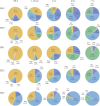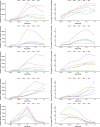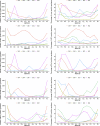Impact of COVID-19 and Nonpharmaceutical Interventions on Common Respiratory Viruses in Children: A 5-Year Study in Hangzhou, China
- PMID: 40294589
- PMCID: PMC12165626
- DOI: 10.1159/000546151
Impact of COVID-19 and Nonpharmaceutical Interventions on Common Respiratory Viruses in Children: A 5-Year Study in Hangzhou, China
Abstract
Background: Nonpharmaceutical Interventions (NPIs) against severe acute respiratory syndrome coronavirus 2 (SARS-CoV-2) not only curbed the spread of novel coronavirus (COVID-19) but also affected common respiratory viruses infected by children.
Methods: Samples of children diagnosed with respiratory tract infection in Children's Hospital affiliated with Zhejiang University from January 2019 to December 2023 were collected, and ADV, Flu A, Flu B, and RSV were detected. Statistical analysis was carried out with R software.
Results: From January 2019 to December 2023, a total of 684,413 samples were tested, including 369,620 males, accounting for 54.01%, and 314,793 females, accounting for 45.99%. Among them, there were 213,443 positive samples (31.19%), of which 40,484 ADV-positive samples (18.97%), 106,423 Flu A-positive samples (49.86%), 32,379 Flu B-positive samples (15.17%), 30,776 RSV-positive samples (14.42%), and 3,381 mixed infection samples (1.58%). Among children of different ages in Hangzhou before, during and after COVID-19, the highest total detection rate of respiratory virus was 4-6 years old (accounting for 36.69%), followed by >7 years old (accounting for 35.10%). The distribution in different seasons shows that the number of children infected with respiratory viruses reaches a peak in winter and spring. Compared with 2019 (33.20%) before the COVID-19 epidemic, the total detection rate of common respiratory viruses in children was lower during the COVID-19 pandemic (24.54% in 2020-2022), and it was increased in 2023 after NPIs were cancelled (accounting for 35.20%).
Conclusion: NPI measures can effectively reduce the spread of common respiratory viruses, Lifting of NPIs can lead children to an increase viral infection rate, particularly in Flu A.
Keywords: 2019 coronavirus disease; Adenovirus; Influenza A virus; Influenza B virus; Respiratory syncytial virus; Respiratory tract infection in children.
© 2025 The Author(s). Published by S. Karger AG, Basel.
Conflict of interest statement
The authors declare that they have no conflicts of interest related to this manuscript.
Figures




Similar articles
-
Impact of Nonpharmaceutical Interventions During the COVID-19 Pandemic on the Epidemiology and Seasonal Patterns of Acute Respiratory Infections in Children.J Med Virol. 2025 Aug;97(8):e70522. doi: 10.1002/jmv.70522. J Med Virol. 2025. PMID: 40736171
-
Changes in the epidemic patterns of respiratory pathogens of children in guangzhou, China during the COVID-19 pandemic.BMC Infect Dis. 2025 Jul 1;25(1):833. doi: 10.1186/s12879-025-11215-8. BMC Infect Dis. 2025. PMID: 40597730 Free PMC article.
-
Dynamics of respiratory virus transmission in children during and after COVID-19 outbreak control in Baiyin, China.BMC Infect Dis. 2025 Jul 7;25(1):901. doi: 10.1186/s12879-025-11285-8. BMC Infect Dis. 2025. PMID: 40624459 Free PMC article.
-
Antibody tests for identification of current and past infection with SARS-CoV-2.Cochrane Database Syst Rev. 2022 Nov 17;11(11):CD013652. doi: 10.1002/14651858.CD013652.pub2. Cochrane Database Syst Rev. 2022. PMID: 36394900 Free PMC article.
-
The impact of coronavirus disease 2019 pandemic on bronchiolitis (lower respiratory tract infection) due to respiratory syncytial virus: A systematic review and meta-analysis.Indian J Public Health. 2023 Apr-Jun;67(2):284-291. doi: 10.4103/ijph.ijph_1334_22. Indian J Public Health. 2023. PMID: 37459026
References
MeSH terms
LinkOut - more resources
Full Text Sources
Medical
Miscellaneous

